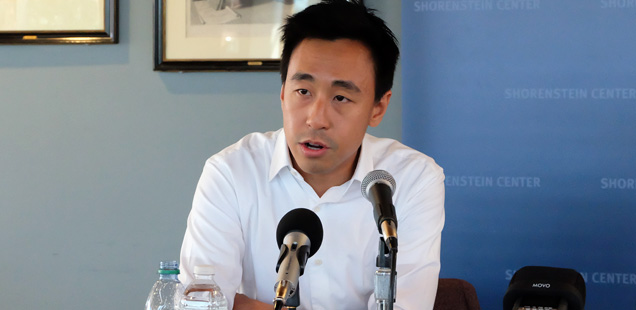October 3, 2017— Gary Liu, CEO of the South China Morning Post, discussed the Hong Kong-based news outlet and its audience, and how he thinks about organizational transformation. Prior to joining SCMP, Liu was the CEO of Digg, where he led the startup’s transformation from aggregator to news platform. Previously, he was head of Spotify Labs, where he managed strategy for global markets. Below are some highlights from his conversation with Nicco Mele, Shorenstein Center director, and the full audio recording. The Shorenstein Center’s podcast is also available on iTunes, Google Play, iHeartRadio, and Stitcher.
On South China Morning Post’s audience
“Our audience is definitely not mainland China. We are a hundred percent blocked in mainland China, we do not have a Chinese language product, we don’t intend on creating a Chinese product—that is not our intent. Our audience today is about 70 percent international and 30 percent Hong Kong…China is still a very restrictive media environment. As Hong Kong press, sometimes treated as foreign press, we have our own difficulties in reporting on China, but at the same time, the freedom of being able to view things with objectivity and actually critique when necessary, but also celebrate when appropriate.”
Why the structure of print newspapers still matters for digital news
When I click on an opinion or I click on an editorial or I click on an objective piece of front page news, they, generally speaking, all look exactly the same to me when I’m consuming it on the internet. We have now raised multiple generations of news consumers that cannot tell the difference…
“Platforms today have atomized the structure of the broadsheet, which I still believe is fundamentally important to understanding what high-quality news looks like…The structure of a traditional broadsheet newspaper lays out the different assets that make up, holistically, what news has been for a long time, and what I believe news needs to continue to be, which is a separation between facts, opinions, and then insights and analysis… Front page facts are supposed to be incredibly objective, not editorialized…And then we’ve always had…opinions, which is the voice of the newspaper, voice of the editor in chief. Opposite to those editorials is the op-ed page, the contributors and commentators that bring in the insights and analysis.”
“When our editorial team is talking about a major piece of news, we will still structure a package of news that includes front page objective facts, our leaders [opinions], as well as the op-eds that go along with it. Here’s the problem: With the platforms through which we discover content today, whether it’s Facebook or Twitter or Google, our interactions with news organizations are singular, they’re one article at a time. And when I click on an opinion or I click on an editorial or I click on an objective piece of front page news, they, generally speaking, all look exactly the same to me when I’m consuming it on the internet. We have now raised multiple generations of news consumers that cannot tell the difference, that do not even know that there is a difference. Sites like the Huffington Post that have been around for over a decade, and really define in a lot of ways how internet news has evolved, have socialized or normalized opinion as front page fact.”
“Understanding the structure of the broadsheet and being able to effectively redeploy and redevelop that with the channels we have available to us, with the canvasses we have available to us today, goes a long way toward a newspaper’s accountability in re-teaching media literacy across the world.”
Leading a digital transformation
“The way that we at SCMP are thinking about our transformation is really in three major parts: The first is culture and identity, the second is structure and process, and the third is product and technology.”
“Culture and identity are massively important when you are trying to turn around a 114-year-old company…until you have a company that is ready to experiment, willing to fail, and able to move with agility…you can talk all day long about transformation and where you’re heading but you’ll never get there.”
“Organization structure has to be broken down and rebuilt. The way that traditional newsrooms are structured does not make sense in today’s world—they’re not fast enough for it, the rhythm and the cadence of operation is different. When I arrived at the South China Morning Post, we as an organization were reviewing numbers on a monthly basis, if we were lucky…in the middle of February we were looking at how we had performed in December. And we were making decisions half-yearly. If we were lucky, every six months we identified what was wrong, we would take another six months to formulate our resolution to that problem, and then execute for six months.”
“Now we have a dedicated print team, and outside of those 25 people, no one else in the newsroom has a right to say what goes where in the printed paper, so now everyone is thinking only about the digital platforms, and the print team is actually curating from the best of the web for tomorrow morning’s paper.”
“Product and technology…that’s pretty foundational—we have to rebuild everything from data infrastructure to the way that we’re thinking about editorial product to the way that we’re thinking about distributed media platforms. All of that is ongoing. It will take three years for us to not only build a technology team, but rebuild the product infrastructure.”
“Editorial product today is the right content with the right packaging for the right distribution channels…Every single one of those looks different. How on earth does a news organization that struggles, today, to even put together even one version of the story correctly, do that across not only scale of audience but multiple different permutations of platforms? That’s a technology struggle that we’re going to have to solve.”
Article and photo by Nilagia McCoy of the Shorenstein Center.


